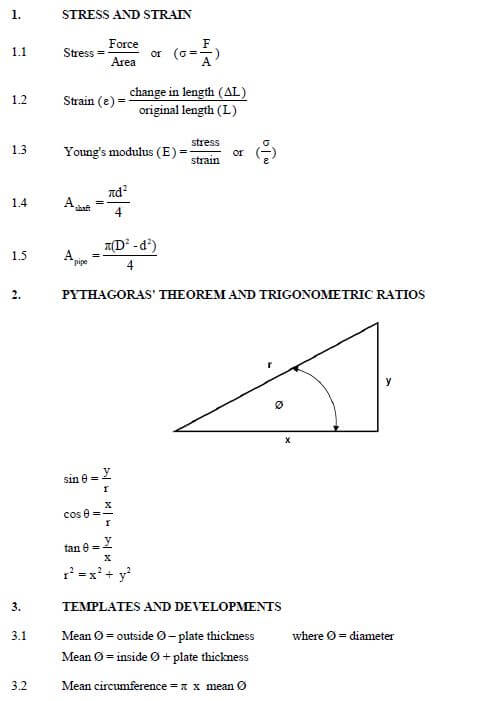MECHANICAL TECHNOLOGY: WELDING AND METALWORK GRADE 12 QUESTIONS - NSC EXAMS PAST PAPERS AND MEMOS NOVEMBER 2018
Share via Whatsapp Join our WhatsApp Group Join our Telegram GroupMECHANICAL TECHNOLOGY: WELDING AND METALWORK
GRADE 12
NSC EXAMS
PAST PAPERS AND MEMOS NOVEMBER 2018
INSTRUCTIONS AND INFORMATION
- Write your examination number and centre number in the spaces provided on the ANSWER BOOK.
- Read ALL the questions carefully.
- Answer ALL the questions.
- Number the answers correctly according to the numbering system used in this question paper.
- Start EACH question on a NEW page.
- Show ALL calculations and units. Round off final answers to TWO decimal places.
- Candidates may use non-programmable scientific calculators and drawing instruments.
- The value of gravitational acceleration should be taken as 10 m/s2.
- All dimensions are in millimetres, unless stated otherwise in the question.
- Write neatly and legibly.
- A formula sheet is attached to the question paper.
- Use the criteria below to assist you in managing your time.
QUESTION | CONTENT | MARKS | TIME in minutes |
GENERIC | |||
1 | Multiple-choice questions | 6 | 6 |
2 | Safety | 10 | 10 |
3 | Materials | 14 | 14 |
SPECIFIC | |||
4 | Multiple-choice questions | 14 | 10 |
5 | Terminology (Templates) | 23 | 20 |
6 | Tools and Equipment | 18 | 15 |
7 | Forces | 45 | 40 |
8 | Joining Methods (Inspection of Weld) | 23 | 20 |
9 | Joining Methods (Stresses and Distortion) | 18 | 20 |
10 | Maintenance | 8 | 10 |
11 | Terminology (Developments) | 21 | 15 |
TOTAL | 200 | 180 | |
QUESTIONS
QUESTION 1: MULTIPLE-CHOICE QUESTIONS (GENERIC)
Various options are provided as possible answers to the following questions. Choose the answer and write only the letter (A–D) next to the question numbers (1.1 to 1.6) in the ANSWER BOOK, e.g. 1.7 E.
1.1 What is the purpose of the Occupational Health and Safety Act, 1993 (Act 85 of 1993) with regard to HIV/Aids awareness?
- The Act on safety states that all employers must make sure that the workplace is safe and that employees are not at risk of becoming infected with HIV at work.
- The Act contains common guidelines on how employers, employees and trade unions should respond to HIV in the workplace.
- Employers may not demote or promote an employee based on his/her HIV status.
- Employers cannot simply dismiss a person who has HIV. (1)
1.2 Which ONE of the following items of personal protective equipment (PPE) is applicable when arc welding is performed on a work piece?
- Hard hat
- Welding goggles
- Welding helmet
- Face shield (1)
1.3 Who is responsible for the provision of safety equipment in the workplace?
- Employer
- Employee
- Customer
- Foreman (1)
1.4 Which ONE of the following properties of solid steel will change if the steel is subjected to a heat treatment process?
- Length
- Hardness
- Size
- Shape (1)
1.5 The purpose of normalising steel is to …
- harden.
- temper.
- harden the core.
- relieve internal stresses. (1)
1.6 If a sound test is performed on high-carbon steel, which ONE of the following sounds will help one to identify the metal?
- Loud clear sound
- Dull sound
- Soft ringing sound
- Low ringing sound (1) [6]
QUESTION 2: SAFETY (GENERIC)
2.1 An angle grinder is used to smoothen a welded joint. State TWO safety measures that must be observed before using the angle grinder. (2)
2.2 Give TWO reasons why it is important to wear welding goggles during oxy-acetylene gas welding. (2)
2.3 Name TWO items of personal protective equipment (PPE) that one will use when working with a hydraulic press. (2)
2.4 Name TWO types of workshop layouts. (2)
2.5 Name TWO responsibilities of the employer when applying first aid in the workplace. (2) [10]
QUESTION 3: MATERIALS (GENERIC)
3.1 Name ONE property of steel that is tested by conducting a bending test. (2)
3.2 Give TWO reasons for conducting EACH of the following heat-treatment processes on steel:
3.2.1 Annealing (2)
3.2.2 Case hardening (2)
3.3 Explain why the tempering of steel is done after the hardening process. (2)
3.4 State the THREE factors that must be considered during all heat-treatment processes. (3)
3.5 Explain the hardening process of steel. (3) [14]
QUESTION 4: MULTIPLE-CHOICE QUESTIONS (SPECIFIC)
Various options are provided as possible answers to the following questions. Choose the answer and write only the letter (A–D) next to the question numbers (4.1 to 4.14) in the ANSWER BOOK, e.g. 4.15 E.
4.1 FIGURE 4.1 below shows a section of a plate girder. Identify part Y. 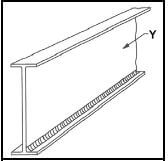
FIGURE 4.1
- Top flange
- Web plate
- Centre plate
- Middle flange (1)
4.2 FIGURE 4.2 below shows a roof truss. Identify component X. 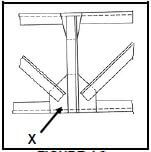
FIGURE 4.2
- Gusset plate
- Rafter
- Plate girder
- Lattice girder (1)
4.3 Which ONE of the following is a tool used to cut a complete screw thread in a blind hole?
- Taper or first tap
- Plug or bottoming tap
- Intermediate tap or second tap
- Starting tap (1)
4.4 The type of deformation that causes permanent elongation is known as …
- longitudinal deformation.
- elastic deformation.
- shrinkage deformation.
- plastic deformation. (1)
4.5 One advantage of plasma cutting when compared to oxy-acetylene cutting is that …
- high-speed and precision cuts are possible.
- non-conductive materials can also be cut.
- it uses only oxygen.
- no skill is needed to operate it. (1)
4.6 What is the magnitude of force X shown in FIGURE 4.6 below? 
FIGURE 4.6
- 6 N
- 4 N
- 8 N
- 12 N (1)
4.7 What does FIGURE 4.7 below represent regarding points X–X? 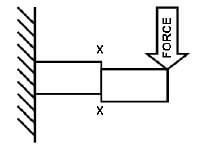
FIGURE 4.7
- Shear moment
- Bending moment
- Bending force
- Shear force (1)
4.8 A strut is defined as a member of a framework designed to …
- hold parts together.
- support beams.
- resist shearing.
- resist compression. (1)
4.9 Which ONE of the following pieces of equipment is associated with oxy acetylene welding?
- Electrode holder
- Earth clamps
- Welding nozzle
- Welding helmet (1)
4.10 Which testing process is represented in FIGURE 4.10 below? 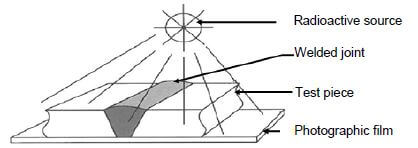
FIGURE 4.10
- Ultrasonic
- Machinability
- X-ray
- Dye penetrant (1)
4.11 Which ONE of the following is a destructive test on a welded joint?
- Nick-break test
- X-ray test
- Light test
- Sound test (1)
4.12 The maximum gap between the tool rest and the grinding wheel on a bench grinding machine is …
- 6 mm.
- 4 mm.
- 5 mm.
- 3 mm. (1)
4.13 Which ONE of the following is a factor to be considered when selecting the cutting speed of a drill bit?
- The use of cutting fluid
- Type of material
- Cutting angle
- Spindle size (1)
4.14 Calculate the value of X as indicated in FIGURE 4.14 below. 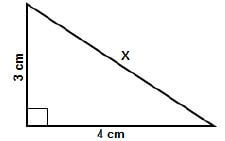
FIGURE 4.14
- 7 cm
- 5 cm
- 6 cm
- 25 cm (1) [14]
QUESTION 5: TERMINOLOGY (TEMPLATES) (SPECIFIC)
5.1 Give TWO reasons why the template loft is separated from the workshop in most cases. (2)
5.2 Describe the purpose of purlins as used on roof trusses. (2)
5.3 A steel ring with an outside diameter of 880 mm must be fabricated from a 50 x 50 mm square steel bar.
5.3.1 Calculate the dimensions of the required material. (7)
5.3.2 Make a neat sketch of the steel ring indicating the mean diameter, outside diameter and the thickness of the material. (4)
5.4 Identify the following resistance weld symbols: 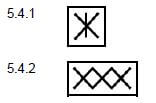 (1)
(1)
5.5 FIGURE 5.5 below shows a welding symbol. Label parts A–F on the welding symbol. 
FIGURE 5.5 (6) [23]
QUESTION 6: TOOLS AND EQUIPMENT (SPECIFIC)
6.1 Briefly describe the working principle of the following machines used in the welding workshop:
6.1.1 Guillotine (4)
6.1.2 Bending rolls (4)
6.2 What is the primary function of the regulators fitted to the gas cylinders of the oxy-acetylene equipment? (3)
6.3 What is the press machine used for in the mechanical workshop? (3)
6.4 FIGURE 6.4 below shows the MIG/MAGS welding process. Label A–D.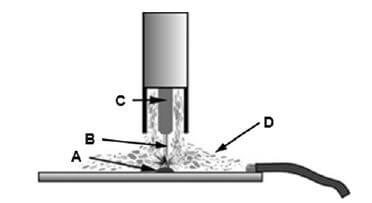
FIGURE 6.4 (4) [18]
QUESTION 7: FORCES (SPECIFIC)
7.1 Determine graphically (Bow's notation) the magnitude and nature of ALL the members of the framework in FIGURE 7.1 below.
SCALE: Vector diagram 1 mm = 5 N 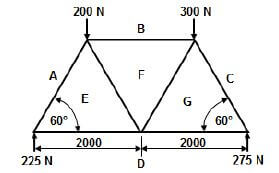
FIGURE 7.1 (20)
7.2 FIGURE 7.2 below shows a simply supported beam that is subjected to THREE point loads. 
FIGURE 7.2
7.2.1 Calculate the reactions at the supports RL and RR. (8)
7.2.2 Calculate the bending moments at points A, B, C, D and E. (5)
7.2.3 Draw a bending moment diagram of the beam. SCALE: 2 mm = 1 kN.m (moments) and 1 : 100 (distances) (5)
7.3 Calculate the load that needs to be applied to a round stainless steel bar to cause a tensile stress of 80 MPa in the material. The diameter of the bar is 20 mm. (7) [45]
QUESTION 8: JOINING METHODS (WELD INSPECTION) (SPECIFIC)
8.1 Name TWO factors that should be taken into account during oxy-acetylene welding to ensure high quality welding. (2)
8.2 What does the abbreviation HAZ stand for with regard to welded joints? (1)
8.3 State TWO causes of EACH of the following arc-welding defects:
8.3.1 Spatter (2)
8.3.2 Undercutting (2)
8.3.3 Incomplete penetration (2)
8.4 State TWO methods to reduce EACH of the following types of cracks during arc-welding:
8.4.1 Transverse cracks (2)
8.4.2 Centre-line cracks (2)
8.5 Explain the difference between a non-destructive test and a destructive test that are conducted on welded joints. (2)
8.6 What type of welding defect occurs when conducting an ultrasonic test on a welded joint? (2)
8.7 Name TWO internal defects that may be detected when conducting a nick break test on a welded joint. (2)
8.8 Explain why a machinability test is conducted on a welded joint. (2)
8.9 State TWO visual requirements for an acceptable weld. (2) [23]
QUESTION 9: JOINING METHODS (STRESSES AND DISTORTION) (SPECIFIC)
9.1 What is residual stress? (2)
9.2 State TWO factors that affect the grain size of cold-worked metals. (2)
9.3 Name TWO quenching media used during the heat treatment of steel. (2)
9.4 Define distortion of the metal that takes place during the welding process. (4)
9.5 Describe TWO factors that affect distortion and residual stress in welding. (4)
9.6 Explain the result when metal is cooled rapidly. Refer to the internal and external areas of the metal. (4) [18]
QUESTION 10: MAINTENANCE (SPECIFIC)
10.1 Give TWO reasons for the maintenance of machines in the welding workshop. (2)
10.2 Give the reason why one applies lock-out on machines during maintenance. (2)
10.3 Give TWO reasons why it is important to keep service records of the machines. (2)
10.4 Name TWO methods to reduce friction when drilling holes. (2) [8]
QUESTION 11: TERMINOLOGY (DEVELOPMENT) (SPECIFIC)
11.1 Describe the function of transformers used in ventilation ducts. (3)
11.2 Use freehand sketches to indicate the difference between an on-centred hopper and an off-centred hopper. (2)
11.3 FIGURE 11.3 below shows a truncated cone. 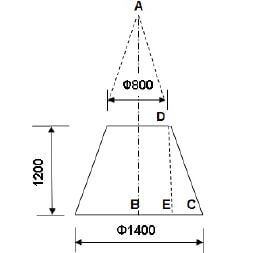
FIGURE 11.3
Calculate the following:
11.3.1 Base circumference (3)
11.3.2 Main radius (AC) (10)
11.3.3 Small radius (AD) (3) [21]
TOTAL: 200
FORMULA SHEET FOR MECHANICAL TECHNOLOGY (WELDING AND METALWORK) 